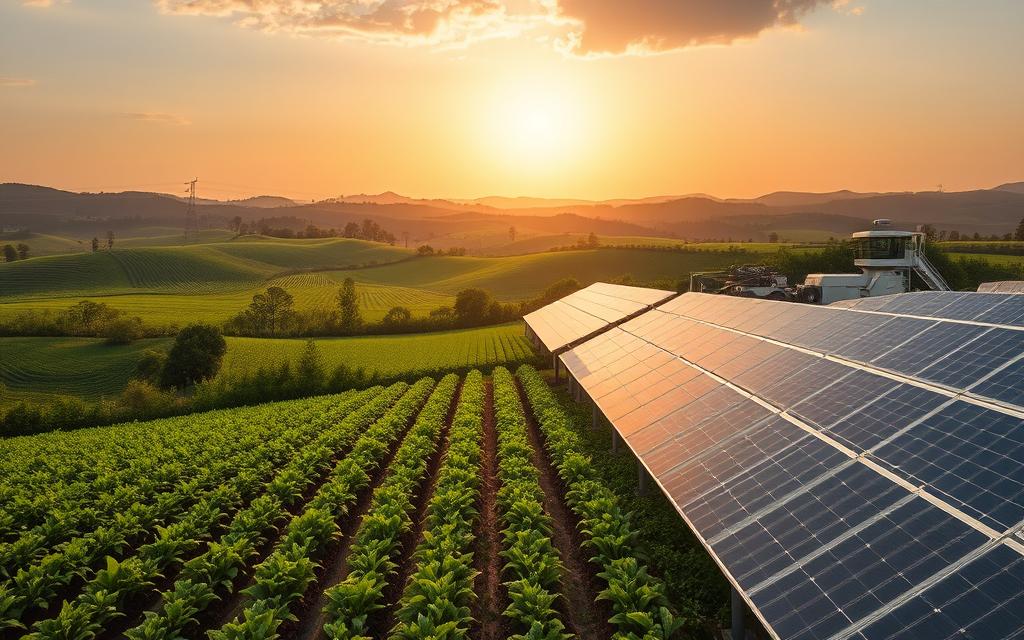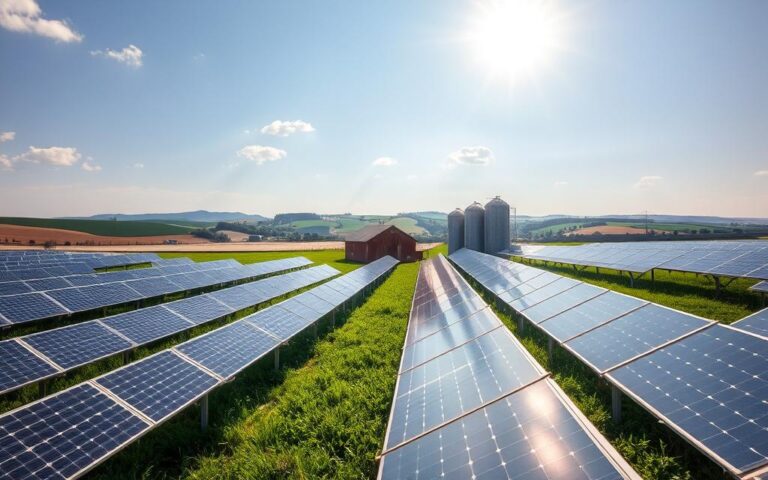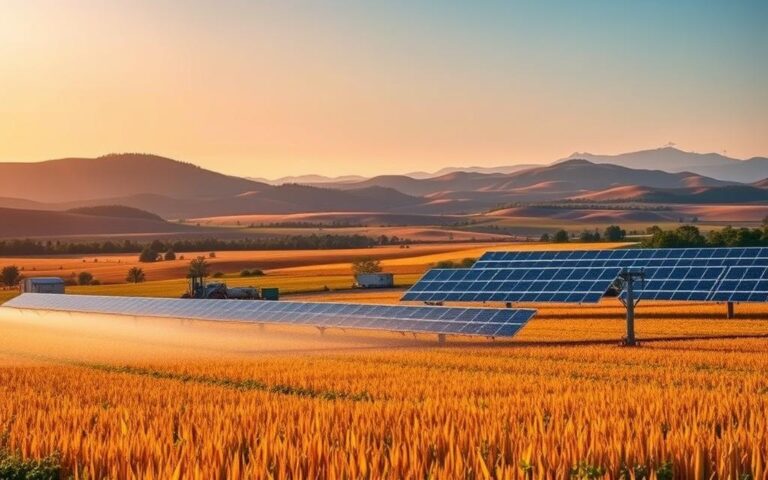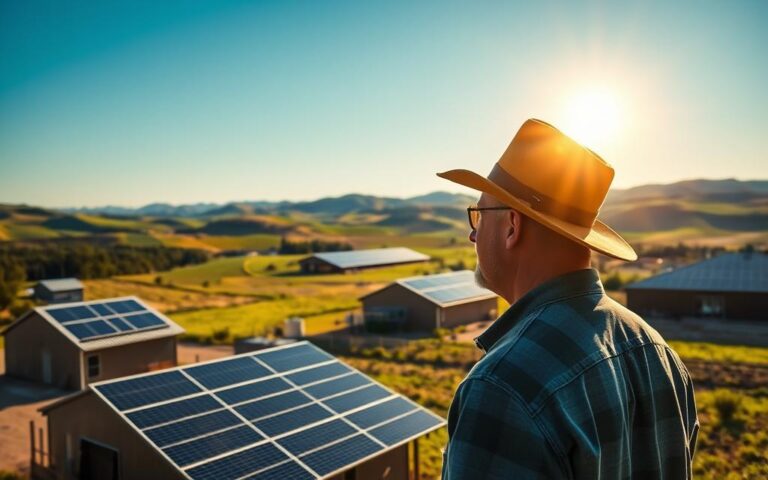Did you know nearly 90% of farmers in the United States want to use renewable energy? This shows a big move towards using solar power for farming. With climate change and high energy costs, solar power for farms is key.
This guide is a must-read for American farmers looking to use solar power. It talks about solar energy’s role in farming, the different systems, and the costs. By using solar energy, farmers can boost their work and help the planet.
Understanding Solar Energy in Agriculture
Solar energy is key to sustainable farming. It uses photovoltaic technology to turn sunlight into electricity. As climate change affects farming, using solar energy is more important than ever.
What is Solar Energy?
Solar energy comes from the sun’s rays. It can be turned into electricity or heat. Solar panels capture sunlight to make power. This clean energy helps farmers use less fossil fuels.
Importance of Renewable Energy for Agriculture
Renewable energy makes farming more stable. Using solar power helps farmers deal with weather extremes. It powers irrigation, heating, and machines, cutting costs and emissions.
Innovative methods like agrivoltaics let crops grow with solar panels. This improves land use and boosts farm productivity.
| Aspect | Solar Energy | Fossil Fuels |
|---|---|---|
| Renewability | Yes | No |
| Environmental Impact | Low | High |
| Operational Cost | Low after installation | Variable |
| Energy Independence | High potential | Low |
Benefits of Solar Energy for Farms
Using solar energy has many benefits for farms. It helps lower costs and is better for the environment. With energy prices going up, farmers are looking at solar systems. These systems help save a lot on electricity bills.
Cost Savings on Electricity Bills
Farms that use solar technology see big cuts in their electricity costs. Studies show savings of over $40,000 in the first year. This is because solar energy lets farms use less power from the grid.
Environmental Benefits of Using Solar
Solar energy is good for the planet. It cuts down on harmful emissions. By using off-grid solar energy for agricultural applications, farms help keep the air and water clean.
Long-term Financial Incentives
Farmers can get financial help for solar technology. Governments offer grants, tax credits, and subsidies. These incentives make solar energy a smart investment for the long run.
Off-Grid Solar for Farms
Off-grid solar systems change the game for farms by giving them power without needing the grid. They use the sun’s energy, making farms sustainable and self-sufficient. As farms need more energy, knowing about off-grid solar is key for better work and less downtime.
What is Off-Grid Solar?
Off-grid solar means systems that don’t need the grid. They have solar panels, batteries, and inverters. This lets farms make, store, and use their own electricity. It’s great for rural areas where grid access is hard or unreliable.
With off-grid solar, farms can keep their energy on when they need it. This is good for things like irrigation and keeping food cold.
Advantages of Off-Grid Solar Solutions
Off-grid solar has many benefits for farms. Some of the main ones are:
- Energy Independence: Farmers make their own electricity, cutting down on outside power needs.
- Cost Savings: While it costs to start, it saves money on electricity bills in the long run.
- Reliability: These systems keep working even when the grid doesn’t, keeping farm work going.
- Environmental Impact: Using solar energy helps farms be greener and more eco-friendly.
Using off-grid solar helps farms be more sustainable and prepares them for the future. More farms are turning to solar power, showing a big step towards being self-sufficient and caring for the planet.
| Advantage | Description |
|---|---|
| Energy Independence | Empowers farmers to control their energy sources and costs. |
| Cost Savings | Lowers ongoing electricity costs after initial installation. |
| Reliability | Ensures power supply during grid disruptions, crucial for farm operations. |
| Environmental Impact | Promotes renewable energy use, helping to fight climate change. |
Types of Solar Power Systems for Agriculture
It’s important for farmers to know about the different solar power systems for agriculture. Each type has its own benefits. This lets farmers choose the best option for their farm and land.
Rooftop Solar Panels
Rooftop solar panels are great for farmers who want to use solar energy without losing land. They can be put on barns, silos, or other buildings. This way, farmers can keep farming while making electricity.
Putting up rooftop solar panels can also save a lot of money on electricity bills. This is because they help reduce the cost of buying electricity from the grid.
Ground-Mounted Solar Systems
Ground-mounted solar systems are another choice for farms. They can be set up in bigger areas. This means they can make more energy than rooftop systems, especially in sunny places.
These systems can be placed in many ways. This makes them good for bigger farms that want to use energy more efficiently.
Agrivoltaics: Combining Crops and Solar Panels
Agrivoltaics is a new way to grow crops and make solar energy at the same time. It lets crops grow under or between solar panels. This makes the most of the land and might even help crops grow better.
By using agrivoltaics, farmers can save on energy costs. They also get to use farming methods that are good for the planet.
| Type of System | Advantages | Best Suited For |
|---|---|---|
| Rooftop Solar Panels | Space-saving, cost-effective, easy installation | Smaller farms, existing structures |
| Ground-Mounted Solar Systems | High energy output, flexible placement | Larger farms with adequate land |
| Agrivoltaics | Dual land use, improved crop production | Irrigated farms, diverse crop types |
Financing Your Solar Installation
Investing in solar energy is a big step for farmers. It helps cut down energy costs and supports sustainability. Looking into grants and incentives can make the cost lower. Knowing the costs of solar panels helps farmers make smart choices and save money in the long run.
Available Grants and Incentives
There are many ways to get financial help for solar projects. State and federal programs offer grants, tax credits, and low-interest loans. Programs like the Rural Energy for America Program (REAP) can be very helpful. Farmers should look into these options to find the best fit for their needs.
Understanding the Cost Structure
It’s important to understand the costs of solar panels for farms. The initial costs include buying equipment, installation, and upgrading infrastructure. Even though it’s a big investment, it can save a lot of money over time. With lower bills and the chance to sell extra energy, solar is a smart choice for many farms.
Installation Process of Solar Systems
Installing solar systems on a farm is key to using renewable energy. It begins with finding the right service providers. The right installer is crucial for a system’s efficiency and reliability.
Knowing the installation timeline helps plan with farm activities. This ensures operations run smoothly without big disruptions.
Choosing the Right Installer
Choosing an installer requires careful thought. Look for companies with experience in farm settings and good reviews. Check their certifications and licenses to make sure they meet industry standards.
Having a consultation before installation can give you a better idea of their work. It also helps know if they offer support after the job is done.
Timeline for Installation
The time needed for installation depends on the project’s size and complexity. It can take anywhere from a few days to weeks. The first steps include site checks and getting permits, which can take longer.
The actual installation usually takes a few days. But, weather and equipment availability can affect this time.

It’s important to coordinate with farm activities during installation. Talking to the installer about timing and needs helps the process go smoothly.
Operation and Maintenance of Solar Farms
Keeping solar farms running well is key to making sure they produce energy for a long time. Regular checks help solar farms work better, letting farmers get the most from their investment. Important steps include keeping up with maintenance and watching how the solar system does. Both help solar tech in farming last longer and work better.
Routine Maintenance Needs
Solar power systems don’t need much care, mostly just regular checks. Farmers should make a plan to look for dust, debris, or damage on panels. Keeping panels clean and in good shape helps them work their best, leading to more energy.
- Regular cleaning of solar panels
- Inspections for any physical obstructions
- Checking electrical connections for compliance
- Monitoring surrounding vegetation growth impacting sunlight exposure
Monitoring Solar System Performance
It’s important to watch how solar systems do to catch any problems early. Using software or apps to track performance lets farmers see how much energy they’re making in real time. These tools help farmers know how to keep their systems running at their best.
- Use of performance monitoring apps
- Setting up alerts for underperformance
- Reviewing energy production data regularly
- Comparative analysis with expected performance metrics
Impact on Crop and Soil Health
Solar panels in farms raise questions about their effect on crops and soil. Knowing these impacts helps farmers choose the right solar energy options.
Effects of Solar Panels on Soil Quality
Studies show solar panels barely affect soil quality. Materials like silicon and aluminum in panels don’t pollute the soil. This means farming can continue without harming the soil.
Keeping soil healthy is key for growing crops well. Solar panels don’t get in the way of this important goal.
Growing Crops Under Solar Arrays
Farmers are now growing crops under solar panels. This method keeps land productive and helps crops grow better. The shade from panels provides the right light and temperature for some plants.
This approach leads to better crop yields and uses resources more efficiently. It combines green energy with farming, benefiting both the environment and farmers’ profits.

Conclusion
American agriculture is changing thanks to solar energy. This change is key for farming’s future. By using solar power, farmers can cut costs and protect the environment.
Farmers who use solar energy are becoming more independent. This helps them keep their businesses stable over time. It’s a big step toward a more sustainable future.
Using new ideas like agrivoltaics helps farmers use their land better. They can grow more crops. Solar energy is also affordable thanks to financial help.
By keeping their systems in good shape and being open to change, farmers can get the most out of solar power. This way, they can save resources for their children and grandchildren.
Using solar energy in farming is a smart move. It helps farmers deal with tough economic times and makes the planet greener. The benefits are clear, making solar energy a key part of farming today.




